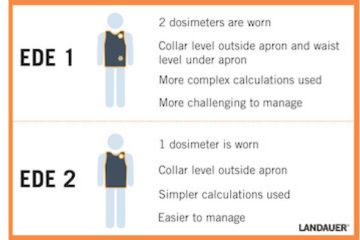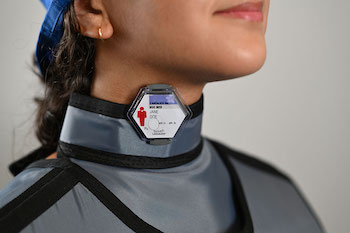
EDE 1 and EDE 2: Understanding Dose Correction Methods for Radiation Workers
Radiology staff working with medical fluoroscopic or cardiac catheterization equipment wear Personal Protective Equipment (PPE) to shield internal tissues and organs from scattered X-rays. However, measurements taken from dosimeters worn outside and above protective aprons can significantly overestimate their actual whole-body radiation dose.
When relying on measurements from a personal dosimeter for external exposure assessment, it is crucial to use the Deep Dose Equivalent (DDE) unless the Effective Dose Equivalent (EDE) is calculated using an approved dosimetry method by a Federal or state agency. In essence, the DDE is used without factoring in the use of PPE and nonuniform exposure. The assigned DDE must correspond to the body area receiving the highest radiation exposure.
When permitted by Federal and state regulations, dosimetry program managers and radiation safety program licensees can apply EDE 1 or EDE 2 dose correction methods to more accurately assess EDE. The EDE 1 and EDE 2 methods account for nonuniform radiation exposure and correct the whole-body dose based on the position of the dosimeter(s) and the shielding transmission factors for PPE (i.e., protective aprons). The Conference of Radiation Control Program Directors (CRCPD) has developed suggested guidelines for the use of these dose correction methods, which apply to individuals licensed or registered by a Federal or state agency to handle radiation sources.
EDE 1 and EDE 2 – What's the Difference?
Here are the key differences between EDE 1 and EDE 2 on dosimetry reports:
Calculation Methods:

EDE 1: When individual monitoring devices are worn both under the protective apron at the waist and outside the protective apron at the collar/neck, the effective dose equivalent for external radiation is calculated by multiplying the deep dose equivalent reported for the dosimeter at the waist under the protective apron by 1.5 and the deep dose equivalent reported for the dosimeter at the neck outside the protective apron by 0.04, and then summing these values.
EDE 2: When only one individual monitoring device is used, located at the collar/neck outside the protective apron, and the reported dose exceeds 25 percent of the annual dose limit, the effective dose equivalent for external radiation is calculated by multiplying the reported deep dose equivalent value by 0.3.
Webster (Reference 4 below) observed that exposure of the face and neck exceeded the exposure recorded under the protective apron by factors between 6 and 27. Applying Webster’s formula and the smallest value in the range (i.e., a factor of six) results in a value of 0.3.
Effect on the Assigned Deep Dose Equivalent:
DDE is a measure of the radiation dose received by deep tissues of the body, such as organs and bone marrow. It is a measure of the part of the body expected to receive the highest exposure (e.g., the abdomen and chest) and an important parameter for assessing the potential health risks associated with radiation exposure.
EDE 1: The assigned DDE calculated using EDE 1 takes into account the shielding provided by PPE and the dosimeter's location. It provides a more accurate estimate of the radiation dose to deep tissues.
EDE 2: The assigned DDE calculated using EDE 2 also considers the shielding provided by PPE and the dosimeter's location, but it uses a simpler method to estimate the dose. It is less accurate than EDE 1 and may overestimate the radiation dose to deep tissues.
EXAMPLE
EDE 2: A single dosimeter worn at the collar measuring 100 mrem DDE would result in an EDE of 30 mrem.
EDE 1: If two dosimeters are worn and the collar dosimeter measured 100 mrem DDE and the waist dosimeter under the lead apron had no measurable dose, the resulting EDE would be 4 mrem.
Applicability:
EDE 1: Radiology staff working with medical fluoroscopic or cardiac catheterization X-ray equipment are issued both a Collar dosimeter and a Waist dosimeter (NCRP 122, paragraph 4.3). The Collar dosimeter is worn outside the protective apron at the collar near the thyroid, and the Waist dosimeter is worn at the waist or on the chest under the protective apron, or over the developing fetus for pregnant personnel. Two dosimeters must be issued and worn as prescribed to obtain accurate results.
 A common problem associated with issuing two dosimeters is the failure of radiology staff to return one or both badges, wearing the collar dosimeter at the waist and vice versa, or otherwise wearing their issued dosimeters improperly. Both dosimeters should be labeled to avoid transposing wear locations (e.g., Collar or Head & Neck and Waist or Whole-Body).
A common problem associated with issuing two dosimeters is the failure of radiology staff to return one or both badges, wearing the collar dosimeter at the waist and vice versa, or otherwise wearing their issued dosimeters improperly. Both dosimeters should be labeled to avoid transposing wear locations (e.g., Collar or Head & Neck and Waist or Whole-Body).
EDE 2: If only one dosimeter is issued, it is worn outside the protective apron at the collar when performing medical fluoroscopic or cardiac catheterization procedures. This method is easier to apply and poses less risk of improper wear.
Who is Required to Receive EDE 1 or EDE 2 Dosimetry Reports
Individuals exposed to medical fluoroscopy: Medical personnel involved in diagnostic and interventional medical procedures, such as cardiologists, interventional radiologists, or radiologic technologists who are not uniformly exposed due to irradiation conditions or protective shielding.
Declared Pregnant Radiation Workers: Pregnant individuals who work with or around medical fluoroscopic or cardiac catheterization X-ray equipment and require monitoring to ensure their radiation exposure remains within safe limits.
Industrial Radiation Workers: In some industries (e.g., Nuclear Power), highly nonuniform radiation fields exist. The use of multiple dosimeters and weighting factors for different parts of the body (i.e., organs and tissues), can result in more accurate estimates of EDE (see reference 5 below).
Can I Apply EDE 1 or EDE 2 Now?
The dosimetry program manager or RSO will consult relevant regulations and guidelines applicable to your jurisdiction to determine the appropriate method for calculating and reporting the EDE. The application of these dose assessment methods may be limited to certain individuals and depend on regulations and guidelines set by Federal regulatory agencies or state authorities.
Conclusions
Those working with medical fluoroscopic or cardiac catheterization equipment are exposed to elevated levels of nonuniform ionizing radiation and require close monitoring to ensure they do not exceed regulatory limits. Accurate results can only be obtained if vigilance is exercised to ensure that dosimeters are worn and returned as prescribed.
Correcting the measured dose using EDE 1 or EDE 2 methods will ensure that dosimetry program managers or radiation safety managers obtain accurate EDE results and maintain radiation dose As Low As Reasonably Achievable (ALARA). The use of EDE 1 or EDE 2 can only be applied in specific circumstances to certain individuals and may require regulatory approval. Consult Federal and/or your state’s radiation protection regulations to ensure that you are calculating and using EDE methods appropriately.
* References:
1. Title 10 Code of Federal Regulations, Part 20
2. NCRP Report 122, Use of Personal Monitors to Estimate Effective Dose Equivalent and Effective Dose to Workers for External Exposure to Low-LET Radiation (not freely available)
3. USNRC Regulatory Guide 8.40, July 2010, Methods for Measuring Effective Dose Equivalent from External Exposure
4. Suggested State Regulations for Control of Radiation produced by the Conference of Radiation Control Program Directors (CRCPD)
5. Webster, E.W., EDE for Exposure with Protective Aprons. Health Physics 56: 568-569, 1989 (not freely available).
6. American National Standard Institute/Health Physics Society, ANSI/HPS N13.41-1997, Criteria for Performing Multiple Dosimetry.
* Remember to consult your state’s radiation protection regulations.
